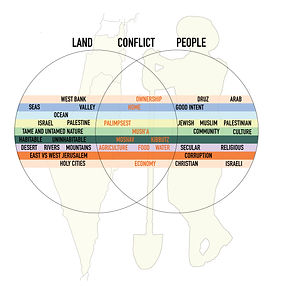Kibbutzim and Moshavim
EXPLORING COMMUNITIES AND THEIR RELATIONSHIPS WITH THE AGRICULTURAL LANDSCAPE IN ISRAEL AND THE WEST BANK
Selected Portions of George H. Cook Honors Thesis
Abstract: This paper will address the different types of agriculturally based communities that Jewish immigrants and pioneers have founded in Ottoman Palestine, British Palestine, Israel, and the West Bank. Of the many different types of communities that exist, two will be the focus of this paper: Kibbutzim and Moshavim. Since their inception in the late 19th century, settlement communities in the land have been inextricably linked to agriculture as a means of survival and livelihood. Agriculture influenced the rise of these communities and contributed to the evolution of agricultural practices and history in Israel and the West Bank. This paper will also demonstrate how these communities interact with a landscape of conflict. Because they are all located in the same geographic area, the settlements can be compared and analyzed. This paper will primarily address how people connect to land through agriculture and through agricultural development.
I wanted to actively immerse myself in the culture of these communities. I discovered an ecological program, “The Green Apprenticeship” offered at Kibbutz Lotan. I stayed in their kibbutz in the Arava Desert for one week, living and contributing to the garden permaculture, and waste-free living. Additionally, Through the WWOOFing (World Wide Opportunities on Organic Farms) program, I volunteered and worked on Moshav Hamra at their small garden on the settlement, and on their organic date plantation in the Jordan Valley.
I wanted to learn more about the unique communities found in Israel and the West Bank. I began asking some questions:
-
What are some different models of communal living?
-
How do these communities operate, and how does their context make their existence possible?
-
How have these agricultural communities changed over time?
-
Why do people choose to live and work in communities?
My overall thesis question is:
How have people historically connected to the landscape through community and agriculture?


Sketches


A Map of Israel highlighting the two case study locations Moshav Hamra, in the West Bank, and Kibbutz Lotan, in the Arava Desert
Five themes emerged as I started to break down the history and culture of the communities I visited and learned about. Each theme is color-coded for simplicity and this color code will appear and remain consistent throughout this paper.
Settlement and community (Blue)
Culture and Personal Identity (Yellow)
Landscape (Green)
Conflict (Orange)
Agriculture (Purple)
These themes are woven throughout the history of kibbutzim and moshavim. Using the colors as a guide, I tried to uncover ways that people interact with the landscapes around them.
Photographs




For kibbutzim and moshavim, agriculture, collectivism, and collaboration were central to the ways of life for the inhabitants of these communities, at varying levels. While observing daily life in Lotan and Hamra, I learned what farmers have done to sustain agriculture in the complex political and cultural environment in Israel and the West Bank. This paper has explored the cultural, social, and political elements that played into the creation of these communities
Timeline Map of Kibbutzim near Lotan





























